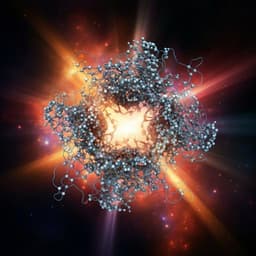
Chemistry
Expedited synthesis of α-amino acids by single-step enantioselective α-amination of carboxylic acids
C. Ye, D. R. Dansby, et al.
Discover a groundbreaking approach to synthesizing high-value α-amino acids in a single step! This research, conducted by Chen-Xi Ye, Drew R. Dansby, Shuming Chen, and Eric Meggers, harnesses iron catalysis and abundant carboxylic acids to provide an efficient and eco-friendly solution in the field of organic chemistry.
~3 min • Beginner • English
Introduction
Amines are ubiquitous in natural products and pharmaceuticals, motivating sustainable, economical routes to C–N bond formation. Transition metal-catalysed nitrene-mediated intermolecular C(sp3)–H amination is attractive for direct hydrogen-to-amine substitution but suffers from challenges in regioselectivity (due to the prevalence of C–H bonds) and stereoselectivity (outer-sphere C–N bond formation when the substrate is not bound to the metal). Directed C–H activation can address these selectivity issues but often relies on noble metals and typically proceeds via cyclometalation. The authors propose a different approach: directed C(sp3)–H amination via nitrene insertion enabled by a coordinating functional group, specifically employing the carboxylate of carboxylic acids as a directing handle. This would allow regioselective and enantioselective α-C–H amination to convert abundant carboxylic acid feedstocks directly into valuable non-racemic α-amino acids (including α,α-disubstituted variants) with a practical N-protecting group. Direct α-amination of free carboxylic acids is rare and challenging due to acid/base issues (acidic carboxyl group and relatively high pKa of the α-C–H). Prior methods either deliver racemic products, require multi-step sequences or strong conditions, or afford limited product classes. Here, the authors aim to develop a single-step, iron-catalysed, enantioselective, directed α-C(sp3)–H nitrene insertion of carboxylic acids that delivers N-Boc-protected α-amino acids with broad scope and high stereocontrol, addressing sustainability via step economy and use of Earth-abundant iron.
Literature Review
Non-directed asymmetric intermolecular C(sp3)–H nitrene insertions are known but often rely on outer-sphere mechanisms with limited stereocontrol. Directed C–H amination via cyclometalation has advanced site- and stereoselectivity but commonly uses noble metals (Pd, Ru, Rh, Ir). Directed C(sp3)–H nitrene insertion without forming C–M bonds has rare precedents: hydrogen bond-mediated catalysis achieving non-racemic outcomes, and racemic reactions via high-valent Ir and Rh nitrenes, with no catalytic asymmetric examples reported. For α-amination of carbonyl compounds, extensive literature covers aldehydes, ketones, 1,3-dicarbonyls, esters, and surrogates; however, direct α-amination of free carboxylic acids is scarce. Yamada et al. (1972) reported one-pot double deprotonation followed by O-methylhydroxylamine, giving racemic products under strong base. Smith et al. (2012) achieved enantioselective organocatalytic α-amination of carboxylic acids via in situ anhydrides with N-aryl-N-aroyldiazenes, ultimately limited to N-aryl-α-glycines after SmI2 cleavage of hydrazides. Shimizu et al. (2019) developed boron-catalysed α-hydrazination with DIAD; a chiral ligand gave only modest ee (45%), and harsh conditions were needed to convert hydrazino to amino groups. Thus, an efficient, enantioselective, single-step α-amination of free carboxylic acids remains an unmet need.
Methodology
Catalyst and design: The authors use a chiral iron complex, (R,R)-[FeCl2(BIP)] (FeBIP), bearing a bis-benzimidazole ligand with a chiral 2,2'-bi-pyrrolidine backbone and two labile chlorides. The carboxylate of the substrate binds iron, directing nitrene insertion at the α-C(sp3)–H. Boc-protected carbamates with various N–O leaving groups (BocNH–X) serve as nitrene precursors.
Optimization: Phenylacetic acid (PAA) was the model. Among leaving groups, mesylate (BocNHOMs) was optimal. Standard conditions: PAA (0.2 mmol), BocNHOMs (2 equiv), piperidine (4 equiv), (R,R)-FeBIP (8 mol%) in o-dichlorobenzene (o-DCB, 0.1 M), −15 °C, 20 h, under N2, affording N-Boc-(S)-phenylglycine in 78% NMR yield (77% isolated) with 93% ee. Benzoate leaving group was ineffective; tosylate and i-Pr sulfonate were less effective. K2CO3 or Et3N as base gave inferior results. CH2Cl2 or MeCN as solvent decreased yield/ee. Higher temperatures diminished yields (likely Lossen-type rearrangement of BocNHOMs). Excess aminating reagent led to oxidative decomposition of product. Alternative chiral iron catalysts (Fe1, Fe2) gave lower yields and/or ee, highlighting the importance of FeBIP with benzimidazole and chloride ligands.
Substrate scope: Broad compatibility with α-aryl acetic acids (various substituents; yields ~49–78%, ee 85–94%), benzannulated and heteroaryl substrates (44–64% yield; 74–93% ee). For certain substrates (e.g., CF3, CO2Me aryl, and some alkyls), CH2Cl2 improved yields. Aliphatic carboxylic acids with unactivated C–H bonds furnished α-amino acids in 30–55% yields, 87–91% ee, exclusively α-selective; electronically activated β-C–H sites can lead to β-amination in specific cases. For sterically hindered aliphatic substrates, yields decreased but ee remained good. Both Boc and Troc protecting groups are compatible. α,α-Disubstituted amino acids were obtained enantioselectively from racemic α-branched acids (enantioconvergent): aryl/alkyl combinations gave 68–89% yield, 79–91% ee; replacing the methyl with various alkyl groups gave 59–85% yield, 93–94% ee; heteroaryl (thiophene) gave 45% yield, 88% ee; fully dialkyl α,α-disubstituted cases showed modest yields and low ee. Late-stage functionalization of complex molecules (isoxepac, diclofenac, indomethacin, lithocholic acid derivative, D-desthiobiotin, ibuprofen, ketoprofen, naproxen) delivered products in 37–88% yields and up to 91% ee.
Mechanistic experiments: Control experiments showed methyl phenylacetate did not react, indicating the free acid (carboxylate binding) is essential. N-benzoate carbamate as nitrene source was ineffective, likely due to benzoate competing for binding. No azanyl ester intermediates were detected under standard conditions. A kinetic isotope effect (kH/kD = 2.0) was observed using PAA vs PAA-d2, indicating C–H cleavage contributes to the rate-determining step. Z→E alkene isomerization of (Z)-4-phenylbut-3-enoic acid under conditions suggests a radical mechanism via allylic radical. α-Amination of enantiopure (R)- and (S)-2-phenylpropanoic acid proceeded stereoconvergently to predominantly (S) product without racemization of recovered acid, indicating a stereoablative step precedes C–N bond formation. Hammett analysis supported strong radical character in the rate-determining intermediate.
Proposed mechanism: Base-induced formation of an iron nitrene (A) from BocNHOMs, followed by substrate carboxylate coordination (B). An intramolecular 1,5-hydrogen atom transfer (HAT) from the α-C–H to the nitrene affords a diradical intermediate (C), which undergoes conformational relaxation. Radical rebound forms the C–N bond (D) in the stereodetermining step; product release regenerates catalyst.
Computations: DFT (B3LYP-D3/def2-TZVPP, SMD(CH2Cl2)//B3LYP-D3/def2-SVP) using propionic acid and a methyl carbamate nitrene model. The pre-HAT resting state (I) is quintet. N–O cleavage to nitrene has a low barrier (~7.9 kcal/mol). Intramolecular 1,5-HAT via quintet TS-1 has a barrier of 9.8 kcal/mol; an alternative outer-sphere HAT is higher (13.3 kcal/mol). The diradical II is triplet in lowest energy. Radical rebound (C–N bond formation) proceeds via quintet TS-2 with an 8.5 kcal/mol barrier, implying a relatively long-lived diradical allowing stereoablation and making rebound enantiodetermining. While HAT favors abstraction of the pro-R hydrogen by 2.1 kcal/mol (which would give R if HAT were enantiodetermining), the observed S product is consistent with stereoablation and enantiodetermining rebound. Lower energy TS-2-S is attributed to a more favorable staggered conformation about the forming C–N bond.
General procedure: In a dry Schlenk tube, add carboxylic acid (1 equiv), BocNHOMs (2–5 equiv), and (R,R)-FeBIP (8–15 mol%). Evacuate/backfill with N2, add solvent (0.1 M) and piperidine (4–7 equiv), seal, and degas by one freeze-pump-thaw. Stir at −15 °C for the indicated time. Workup: dilute with Et2O, wash with 1 M NaHSO4, extract aqueous with Et2O, dry organic layer (Na2SO4), filter, evaporate, and purify by silica gel chromatography (EtOAc/hexane with 0.2% AcOH) to obtain products.
Key Findings
- Established a single-step, enantioselective, directed α-C(sp3)–H amination of free carboxylic acids using an iron catalyst to afford N-Boc-protected α-amino acids.
- Optimal conditions: (R,R)-FeBIP (8 mol%), BocNHOMs (2 equiv), piperidine (4 equiv), o-DCB, −15 °C, 20 h; model reaction (phenylacetic acid → N-Boc-(S)-phenylglycine) gave 77% isolated yield, 93% ee.
- Scope highlights:
• α-Aryl amino acids: 49–78% yields, 85–94% ee across diverse substituents (Me, tBu, Ph, OMe, F, Cl, N3, CF3, CO2Me, benzannulated, heteroaryl). Some substrates benefited from CH2Cl2 solvent.
• α-Alkyl amino acids: 30–55% yields, 87–91% ee; sterically hindered substrates gave lower yields (e.g., 21% for 3,3-dimethylbutanoic acid) but maintained high ee (~89–90%). Regioselectivity: exclusive α-amination for unactivated aliphatic chains; β-amination only when β C–H is electronically activated (substrate-dependent).
• α,α-Disubstituted amino acids from racemic acids (enantio-convergent): aryl/alkyl cases 68–89% yield, 79–91% ee (e.g., para- and meta-aryl variants at 80–89% yield, 91% ee). Alkyl variants (Et, n-Pr, i-Pr, Cy) 59–85% yields, 93–94% ee. Heteroaryl (thiophene) 45% yield, 88% ee. Fully dialkyl α,α-disubstituted substrates showed modest yields (34–43%) and poor ee (23–43%).
• Late-stage functionalization: isoxepac (59%, 90% ee), diclofenac (37%, 83% ee), indomethacin (75%, 70% ee), TBS-lithocholic acid (43%, 23:1 d.r.), D-desthiobiotin (40%, 21:1 d.r.), ibuprofen (87%, 91% ee), ketoprofen (88%, 90% ee), naproxen (65%, 85% ee).
- Mechanistic insights:
• Free carboxylic acid is essential (esters unreactive); nitrene precursor leaving group critical (mesylate best; benzoate ineffective).
• Kinetic isotope effect kH/kD = 2.0 indicates C–H cleavage contributes to rate limitation.
• Z→E isomerization of allylic substrate supports radical intermediates.
• Stereoconvergent outcomes for α-branched acids with minimal racemization of recovered acids suggest a stereoablative step precedes enantiodetermining C–N bond formation.
• DFT supports intramolecular 1,5-HAT (ΔG‡ ~9.8 kcal/mol) to a long-lived diradical, followed by enantiodetermining radical rebound (ΔG‡ ~8.5 kcal/mol); outer-sphere HAT is disfavored (ΔG‡ ~13.3 kcal/mol).
- Sustainability and practicality: step-efficient, uses Earth-abundant iron, delivers Boc-protected products directly suitable for peptide synthesis; Troc protecting group also compatible.
Discussion
The study addresses the core challenges of intermolecular C(sp3)–H amination—regio- and stereoselectivity—by leveraging substrate coordination via the carboxylate to a chiral iron nitrene catalyst. This directed strategy positions the α-C–H for selective 1,5-HAT and subsequent stereocontrolled radical rebound, enabling high enantioselectivity without forming a prior C–M bond. The broad substrate scope, including unactivated aliphatic acids and α,α-disubstituted systems, demonstrates generality. Late-stage functionalization of pharmaceuticals underscores practical utility. Mechanistic experiments and DFT converge on a radical pathway where C–N bond-forming radical rebound is enantiodetermining, rationalizing enantioconvergence for racemic α-branched substrates and the observed S-selectivity despite HAT’s intrinsic pro-R preference. Compared to prior methods that require strong bases, multi-step sequences, or deliver racemic products, this protocol achieves a one-step, enantioselective transformation using an Earth-abundant metal and a practical protecting group, advancing sustainable amine synthesis.
Conclusion
An expedited, catalytic asymmetric method was developed for converting free carboxylic acids to N-protected chiral α-amino acids via a single-step, directed α-C(sp3)–H nitrene insertion using a chiral iron catalyst. The protocol delivers α-monosubstituted and α,α-disubstituted amino acids with high enantioselectivity across a wide substrate range and enables late-stage modification of complex molecules. Mechanistic data and DFT calculations support an intramolecular 1,5-HAT to a long-lived diradical followed by an enantiodetermining radical rebound step, with the carboxylate functioning as a directing group. This work prototypes asymmetric intermolecular C–H amination via directed nitrene insertion with a non-noble metal catalyst. Future directions include improving outcomes for fully dialkyl α,α-disubstituted substrates, expanding to other directing groups and protecting groups, optimizing conditions for sensitive functionalities, and extending catalyst designs to broaden scope and reactivity.
Limitations
- Substrate limitation: Esters (e.g., methyl phenylacetate) do not react; the free carboxylic acid is required for coordination. Fully dialkyl α,α-disubstituted substrates give modest yields and low ee (e.g., 34–43% yield; 23–43% ee). Sterically hindered aliphatic acids can give reduced yields.
- Competing reactivity: Electronically activated β-C–H bonds can undergo β-amination in specific cases (substrate-dependent), though unactivated aliphatic chains show exclusive α-selectivity.
- Conditions sensitivity: Higher temperatures reduce yields (Lossen-type rearrangement of BocNHOMs); excess aminating reagent can cause oxidative product decomposition; solvent and base choices significantly impact yield/ee (o-DCB and piperidine optimal in many cases).
- Reagent/catalyst specificity: Mesylate leaving group on the nitrene precursor is critical; N-benzoate carbamate is ineffective under these conditions. Alternative iron catalysts (Fe1, Fe2) are inferior to FeBIP in yield/ee.
- Operational constraints: Low temperature (−15 °C), inert atmosphere, and specific workup/purification needed; some late-stage products isolated as esters or required modified stoichiometry.
- Enantioselectivity limitations: Certain substrates (e.g., some heteroaryl/disubstituted cases) show lower ee (down to ~70–79%).
Related Publications
Explore these studies to deepen your understanding of the subject.







